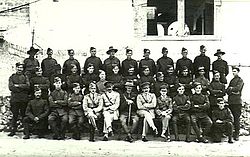No. 40 Wing RAF
| No. 40 Wing RAF |
|
|---|---|

Headquarters 40th (Army) Wing RAF, Palestine, 1918
|
|
| Active | 5 October 1917 – 1 April 1920 |
| Country |
|
| Branch |
British Army (before 1 April 1918) Royal Air Force (after 1 April 1918) |
| Type | Aircraft |
| Role | Counter-air Bombing Photo-reconnaissance |
| Size | 4 squadrons |
| Part of | Palestine Brigade |
| Base |
Ramleh (1918) Ismailia (1919–20) |
| Engagements | Battle of Megiddo |
| Commanders | |
| Notable commanders |
Amyas Borton Richard Williams |
| Aircraft flown | |
| Bomber |
Airco DH.9 Handley Page O/400 |
| Fighter |
Bristol F.2 Fighter Royal Aircraft Factory S.E.5 |
No. 40 Wing formed part of the Royal Air Force (RAF) Palestine Brigade during World War I and immediately after. It was established in October 1917 as 40th (Army) Wing, Royal Flying Corps (RFC), and become part of the RAF in April 1918, when the RFC merged with the Royal Naval Air Service. The wing played a major part in the Battle of Megiddo, the last great offensive against the Ottoman Empire, in September 1918. It was disbanded in April 1920.
40th (Army) Wing RFC was formed on 5 October 1917, under the control of the RFC's Palestine Brigade. Its primary roles were counter-air operations and attacks on enemy infrastructure. It also undertook extensive photo-reconnaissance work. Another formation under the Palestine Brigade, 5th (Corps) Wing, performed air cooperation and close air support tasks. 40th Wing's first Officer Commanding was Lieutenant Colonel Amyas Borton; he was succeeded by Alexander Shekleton in late 1917. In June 1918, Lieutenant Colonel Richard Williams of the Australian Flying Corps (AFC) took command of the wing, with No. 1 Squadron AFC and three RFC squadrons—Nos. 111, 144, and 145—at his disposal. No. 145 Squadron was also commanded by an Australian, Captain Roy Drummond. Based at Ramleh, the wing's inventory consisted of Bristol F.2B and S.E.5 fighters and DH.9 light bombers.
...
Wikipedia
